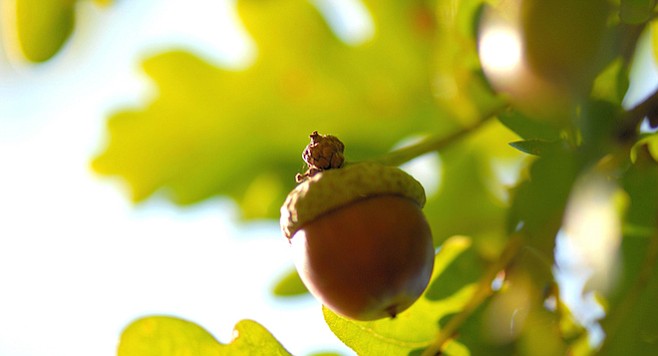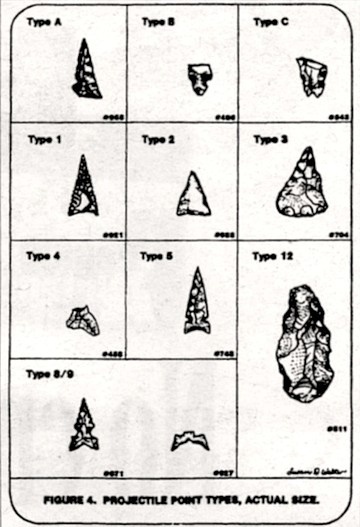 Facebook
Facebook
 X
X
 Instagram
Instagram
 TikTok
TikTok
 Youtube
Youtube

During a survey of 94 acres on Rancho Jamul, on March 9,1982, Susan Melinda Hector discovered a site where Late Prehistoric “hunter-gatherers” lived. Along with several assistants, Hector excavated the site in 1982 and 1983 and wrote the findings in her doctoral dissertation.

Hector renamed site SDi-9476 as “Pio Pico,” because it’s directly across Otay Lakes Road from the campground by the same name. The site is 16,000 square meters and lies on an alluvial terrace above Dulzura Creek, east of the confluence with Jamul Creek. The two creeks empty into Lower Otay Reservoir two miles west of the site. The rugged topography — Jamul mountains to the west, San Ysidro mountains to the south — includes abundant natural springs and “seeps.”
Based on its types of pottery and radio carbon testing. Hector classified the site as Late Prehistoric. Charcoal samples dated 330 B.P. (Before Present) and 250 B.P. indicate a phase of prehistory that began around 1000 A.D. and remained intact until the Spanish entered the area.
Like the previous cultures in San Diego, the Late Prehistoric people in Southern San Diego belonged to a Yuman linguistic group that came from the Colorado Desert. They were “collectors” and used a single village as a base camp throughout the year.
Hector and her assistants analyzed tools, bones, flakes of stone, and other indicators of activity in the area. She determined that the site was “homogeneous,” meaning that each family conducted all required activities.
The main meat source was jackrabbit, cottontail, and small rodents, plus the occasional mule deer, duck, valley quail, and small quantities of shellfish. These latter were mussels brought hack from foraging missions to the ocean (fishbones of sharks and rays also show evidence of these trips). The mussels were poisonous in summer and fall. But in winter and spring — times of food scarcity — they provided a valuable supplement.
The people also roasted grasshoppers, yuccas, and ate abalone (using the shells for ceremonies). But their number-one food source was the acorn, shaken from the branches of Coast Live Oak trees. They poured hot water through baskets of acorns to leach out the bitter-tasting tannin. Hector estimates that there were enough oaks at the Pio Pico site to support at most 33 villages — and a minimum of 3. “The nutrients in the acorns, combined with other foods, provided a complete diet for an individual.”
The excavation produced many shards of pottery. This was “Tizon Brownware,” a brown, smooth, unpolished pottery made from granitic clays and native to the region. Pottery first came to the San Diego area between 1300 A.D. and 1000 A.D.
Excavation — with all soils passed through a one-inch mesh screen — also produced 142 flaked stone tools, suggesting that a great amount of tool-production took place at Pio Pico.
In conclusion, Hector says, “the site was occupied immediately prior to Spanish entry into the area.” The site enjoyed “perennially watered valleys” and, because it permitted large communities to “develop and thrive,” Hector regards it as the hunter-gatherer’s “ultimate adaptation to the region.”


During a survey of 94 acres on Rancho Jamul, on March 9,1982, Susan Melinda Hector discovered a site where Late Prehistoric “hunter-gatherers” lived. Along with several assistants, Hector excavated the site in 1982 and 1983 and wrote the findings in her doctoral dissertation.

Hector renamed site SDi-9476 as “Pio Pico,” because it’s directly across Otay Lakes Road from the campground by the same name. The site is 16,000 square meters and lies on an alluvial terrace above Dulzura Creek, east of the confluence with Jamul Creek. The two creeks empty into Lower Otay Reservoir two miles west of the site. The rugged topography — Jamul mountains to the west, San Ysidro mountains to the south — includes abundant natural springs and “seeps.”
Based on its types of pottery and radio carbon testing. Hector classified the site as Late Prehistoric. Charcoal samples dated 330 B.P. (Before Present) and 250 B.P. indicate a phase of prehistory that began around 1000 A.D. and remained intact until the Spanish entered the area.
Like the previous cultures in San Diego, the Late Prehistoric people in Southern San Diego belonged to a Yuman linguistic group that came from the Colorado Desert. They were “collectors” and used a single village as a base camp throughout the year.
Hector and her assistants analyzed tools, bones, flakes of stone, and other indicators of activity in the area. She determined that the site was “homogeneous,” meaning that each family conducted all required activities.
The main meat source was jackrabbit, cottontail, and small rodents, plus the occasional mule deer, duck, valley quail, and small quantities of shellfish. These latter were mussels brought hack from foraging missions to the ocean (fishbones of sharks and rays also show evidence of these trips). The mussels were poisonous in summer and fall. But in winter and spring — times of food scarcity — they provided a valuable supplement.
The people also roasted grasshoppers, yuccas, and ate abalone (using the shells for ceremonies). But their number-one food source was the acorn, shaken from the branches of Coast Live Oak trees. They poured hot water through baskets of acorns to leach out the bitter-tasting tannin. Hector estimates that there were enough oaks at the Pio Pico site to support at most 33 villages — and a minimum of 3. “The nutrients in the acorns, combined with other foods, provided a complete diet for an individual.”
The excavation produced many shards of pottery. This was “Tizon Brownware,” a brown, smooth, unpolished pottery made from granitic clays and native to the region. Pottery first came to the San Diego area between 1300 A.D. and 1000 A.D.
Excavation — with all soils passed through a one-inch mesh screen — also produced 142 flaked stone tools, suggesting that a great amount of tool-production took place at Pio Pico.
In conclusion, Hector says, “the site was occupied immediately prior to Spanish entry into the area.” The site enjoyed “perennially watered valleys” and, because it permitted large communities to “develop and thrive,” Hector regards it as the hunter-gatherer’s “ultimate adaptation to the region.”
Comments